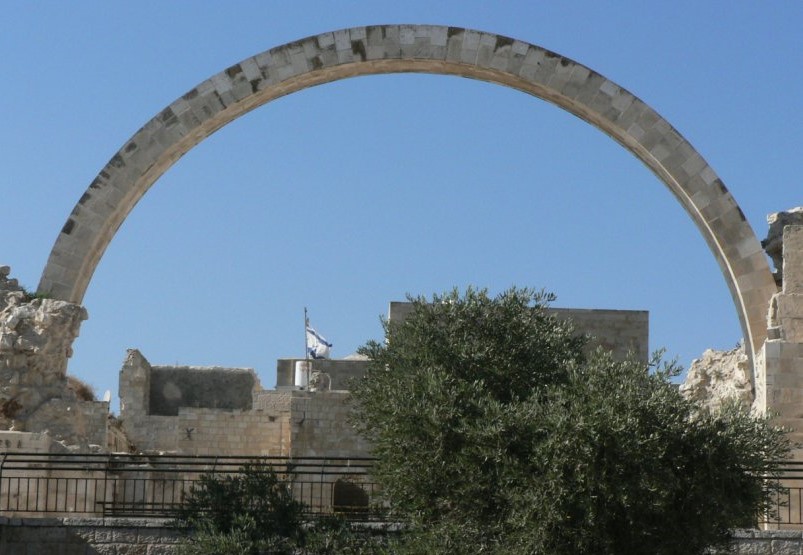The Ruin that Still Stands

בית הכנסת "החורבה", או בשמו המלא "חורבת רבי יהודה החסיד", הוא אחד מבתי הכנסת המרכזיים ברובע היהודי של העיר העתיקה בירושלים. הוא בולט למרחוק בזכות כיפתו הגדולה והלבנה, ומשמש כאחד מהסמלים המרכזיים של הרובע היהודי ושל העיר העתיקה כולה.
בית הכנסת נמצא במרכז "חצר האשכנזים" (בערבית: "דיר אל-שיכנז"), מתחם אשר נרכש על ידי יהודים מהקהילה האשכנזית בראשית המאה ה- 15 מהמוסלמים. אנשי הקהילה בנו במתחם בית כנסת קטן, הראשון במספר, וכמה מבנים נוספים. בשנת 1692 התמוטט בית הכנסת הראשון. בני הקהילה גייסו תרומות והחלו להקים בית כנסת חדש, השני במספר, אשר הושלם בראשית שנת 1700. שמו של בית הכנסת הזה נקשר עם רבי יהודה החסיד שעלה לארץ ישראל מפולין עם מאות מחסידיו והגיע לירושלים לקראת סוף אותה שנה. בשנת 1720 נחרב בית הכנסת על ידי נושים ערבים בשל חובות שלא שולמו, והיהודים האשכנזים גורשו מירושלים. המתחם נותר הרוס במשך כ- 100 שנה, ומכאן זכה בית הכנסת לכינויו החורבה.
בתחילת המאה ה- 18 חזרו יהודים אשכנזים להתגורר בעיר העתיקה. בשנת 1837 התקבל אישור משליט מצרים, מוחמד עלי, לבניית בית כנסת חדש. בנייתו של בית הכנסת, השלישי במספר, החלה רק כעשרים שנה לאחר מכן, בשנת 1857, בחסותם של הנדבן משה מונטיפיורי והברון אלפונס ממשפחת רוטשילד. בית הכנסת אף נקרא "בית יעקב" על שמו של אבי הברון, ג'יימס יעקב. הוא נחנך לבסוף ברוב טקס בשנת 1864, ולמרות גודלו ופארו המשיך להיות מוכר בכינויו העממי "החורבה". סביב בית הכנסת שכנו גם המוסדות המרכזיים של הקהילה האשכנזית בירושלים.

After the occupation of East Jerusalem by the soldiers of the Arab Legion, the synagogue was blown up on May 27, 1948 and destroyed, along with large parts of the Jewish Quarter. After the occupation of Jerusalem in the Six Day War in 1967, the synagogue was not rebuilt as part of the district's reconstruction plan. For years there was only one large arch that was symbolically restored to mark the synagogue.

Only at the beginning of the 21st century was it decided to restore the synagogue, for the fourth time, and construction began in 2003. During archaeological excavations that took place in the area where the synagogue stood, remains from the Second Temple period and the Byzantine period were found, which are currently displayed in its basement. The structure of the new synagogue was based on its predecessor, and some of the surviving ruins were even incorporated into the new building. The interior of the synagogue was designed and restored as accurately as possible, based on photos, testimonies and a model built in 1912. Once the construction and restoration process finished, the synagogue was inaugurated in 2010.
במהלך הבנייה מחדש של בית הכנסת התגלה סליק שנבנה על ידי האצ"ל מתחת למיקומו של ארון הקודש. הסליק נבנה בשנת 1942 כחלק מתוכנית למאבק בכיבוש אפשרי של ארץ ישראל על ידי הנאצים. הסליק לא היה ידוע למגיני הרובע במלחמת העצמאות, ולאחר נפילת העיר העתיקה בידי הירדנים הוא נשכח לגמרי.
From the roof of the synagogue there is a wonderful view of the old city and its surroundings.
(Anecdote authored by: עמיר)
(Number of views: 58)
